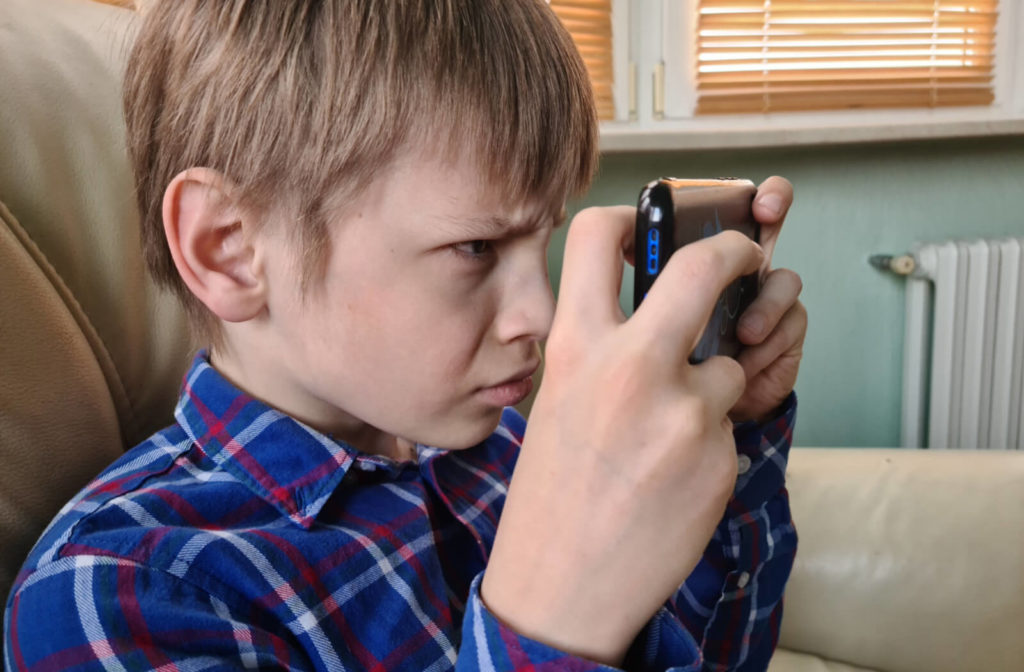Nearsightedness and farsightedness are refractive errors that can affect your ability to see clearly close-up and far away.
Your eye doctor can diagnose nearsightedness and farsightedness with the help of an eye exam. While they are both common, nearsightedness is more common than farsightedness.
What Is Nearsightedness?
Your eyes behave like a camera, capable of focusing on nearby or distant objects by adjusting the shape of the lens. When light enters the eye, it focuses on the retina (the light-sensitive tissue at the back of the eye) to produce a clear image. However, due to an abnormal shape or length of the eyeball, light doesn’t focus properly on the retina, causing blurry vision.
Nearsightedness, or myopia, is like having a clear view of something close by but blurry distance vision. It results from a too-long eyeball or a too-steeply curved cornea (the transparent front layer of the eye) that causes light to focus in front of the retina instead of directly on it.
Symptoms of nearsightedness can include the following:
- Blurry distance vision
- Squinting to see clearly
- Eye strain
- Eye fatigue
- Sore eyes
What Is Farsightedness?
Farsightedness, or hyperopia, is the opposite of nearsightedness. It’s like having a built-in zoom feature for distant objects but having blurry vision for objects closer than arm’s length. Farsightedness results from a too-short eyeball or a cornea with less curvature, making it difficult for light to focus on the retina and focus behind the retina instead.
Symptoms of farsightedness can include the following:
- Blurry near vision
- Eye strain
- Headaches
- Burning or sore eyes
Farsightedness often becomes more noticeable as you age. With age, the eye’s lens becomes less flexible, making it challenging to focus on close-up tasks.
Untreated farsightedness in children can lead to complications, such as:
- Strabismus (when the eyes don’t align properly)
- Amblyopia (when there’s reduced vision in one eye)
Why Nearsightedness Is More Common than Farsightedness
Nearsightedness affects almost 30% of people worldwide and is expected to rise to 50% by 2050. Several reasons explain why nearsightedness is more common than farsightedness.
Genetics
Reports on the prevalence of nearsightedness in some populations show the impact of genetic factors on the onset and progression of nearsightedness. A family history of nearsightedness in parents correlates with nearsightedness in their children.
Age
Myopia usually develops in childhood, between 6 and 14 years, and stabilizes around early adulthood. During this time, the eyes continue to grow. However, acceleration of the axial length of the eyeball can lead to nearsightedness in children.
Early diagnosis and treatment can help prevent high myopia and myopia progression. Progression of myopia can increase an individual’s risk of some vision-threatening eye conditions.
Near-Focussed Activities
In this digital era, our eyes are clocking in extended periods in front of screens of all sizes. From desktop monitors to tablets and pocket-sized smartphones, our eyes are getting a workout like never before, leading to a growing health concern.
Spending long periods of time doing near-focused activities, such as staring at screens for work or learning, can increase your risk of nearsightedness in children and adults.
How to Reduce Your Risk of Nearsightedness & Farsightedness
Due to the prevalence of nearsightedness and farsightedness, it’s crucial not to dismiss eye health issues as minor problems. Untreated nearsightedness can lead to complications such as glaucoma, cataracts, and retinal detachment, which could result in permanent vision loss.
Regular comprehensive eye exams are vital for maintaining good eye health and preventing potential vision issues. Other measures to reduce your risk of nearsightedness and farsightedness can include the following:
- Increasing outdoor time to avoid high levels of near-focused activities
- Taking frequent breaks from screen time
- Encouraging 2 hours of daylight exposure for children.
- Using atropine eye drops
- Using corrective lenses like glasses or contact lenses compensate for an irregular eye or cornea shape
- Getting surgery refractive surgery to reshape your cornea

We Care About Your Eye Health
Regular eye exams can help detect early signs of nearsightedness and farsightedness and provide recommendations on treatment to help maintain long-term eye health. Book your next eye exam with Total Vision Sports Arena. Our friendly and experienced team is here to support you and address your vision concerns.



